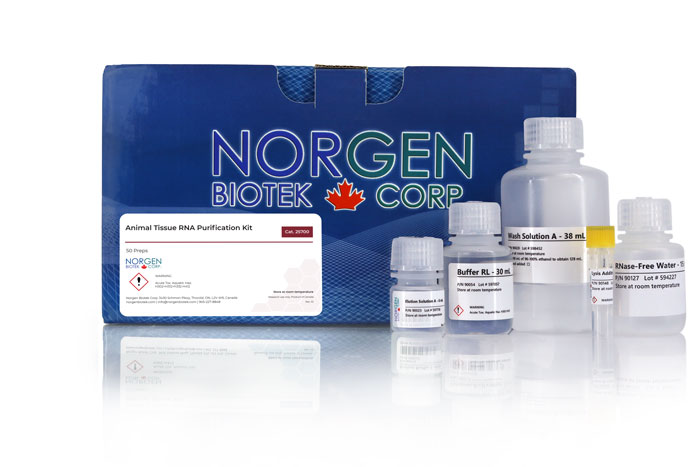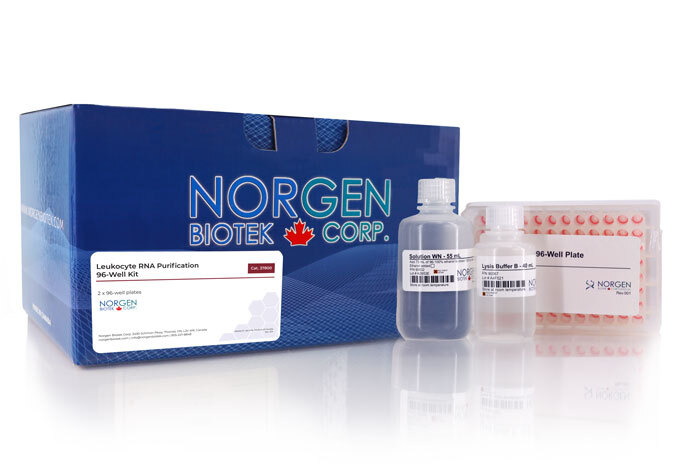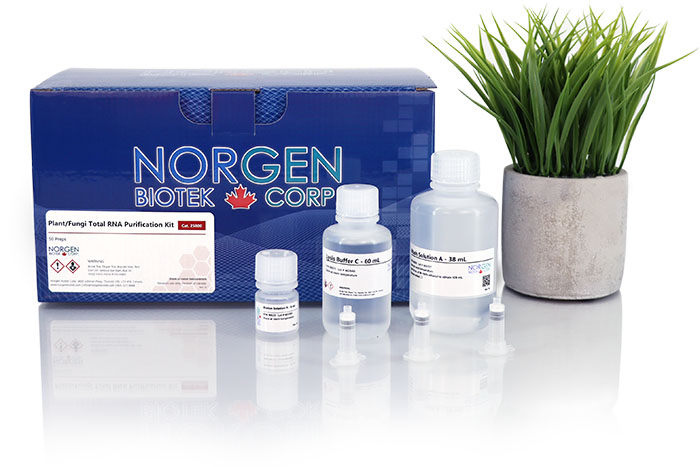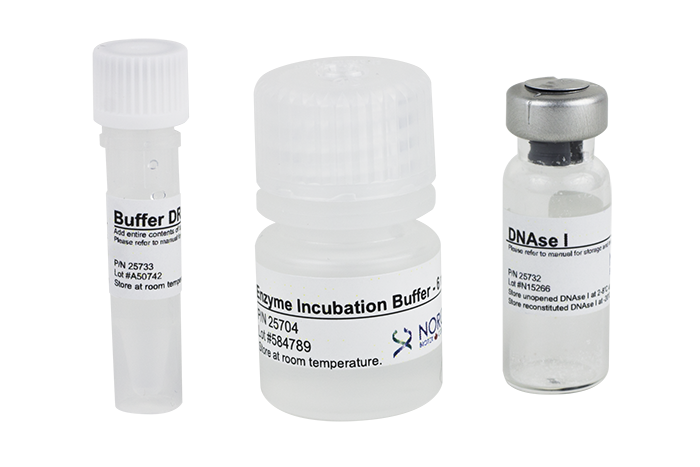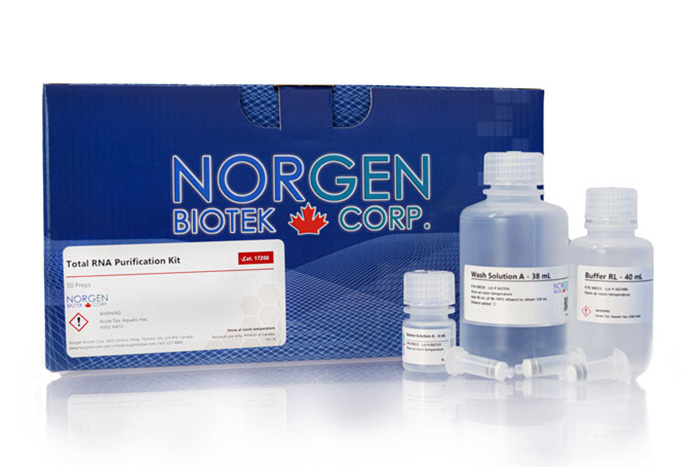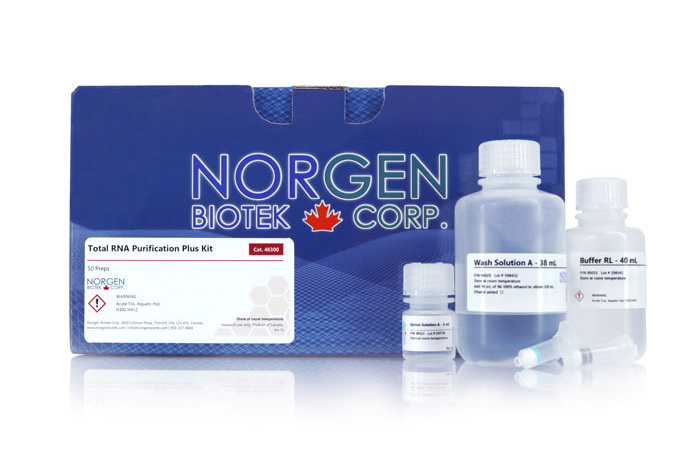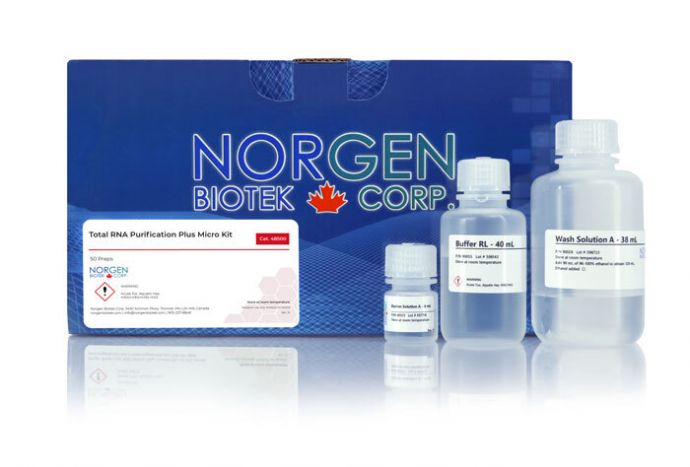Total RNA Purification Micro Kit
Rapid purification of total RNA - including microRNA - from small input amounts
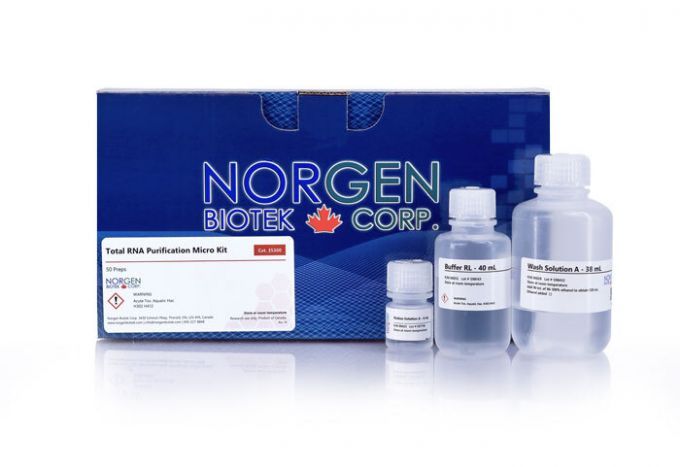
For research use only and NOT intended for in vitro diagnostics.
Total RNA Purification Micro Kit
Rapid purification of total RNA - including microRNA - from small input amounts
Register today to receive an exclusive 15% off* on your first order.
Features and Benefits
- Extract high quality & quantity total RNA including miRNA
- No phenol step required - isolate all RNA in one fraction
- Elute extracted total RNA in small volume (20 µL)
- Bind & elute all RNA irrespective of size or GC content, without bias.
- Efficiently extract small RNA irrespective of GC content
- Very sensitive & linear down to a few cells without the need for carrier RNA
- Convenient & fast spin column format
- Isolate from a wide variety of specimens
- Purified RNA is suitable for a variety of downstream applications, including Small RNA Sequencing. Find out more information on Norgen's NGS services
- Purification is based on spin column chromatography that uses Norgen’s proprietary resin separation matrix
This kit extracts total RNA from low cell number samples and elutes in a convenient 20 µL elution for a number of downstream applications.
This kit is suitable for the isolation of total RNA from a range of samples including small input of cells, needle biopsies, LCM, CTC and other low cell number samples. Extract high quality and purity RNA with excellent RIN values and A260/A280 suitable for downstream applications including qRT-PCR, RT-PCR, microarrays, NGS and more.
The kit purifies all sizes of RNA from large mRNA, lncRNA down to microRNA (miRNA) in the same fraction without the requirement of phenol. Isolate all RNA sequences at an equal rate irrespective of size. Moreover, when the RNA sequences are small (e.g. miRNA), the column binds small RNAs regardless of their GC content.
Isolate RNA after Purifying EVs and Exosomes
Ultracentrifugation, Exoquick, Filtration
| Cat. # | Name | Elution Volume | Plasma/Serum | Urine | Cell-Culture Media |
|---|---|---|---|---|---|
| 55000 | Plasma/Serum RNA Purification Mini Kit | 10 - 25 µL | 50 µL - 1 mL | 250 µL - 1 mL | 5 - 10 mL |
| 35300 | Total RNA Purification Micro Kit | 20 - 50 µL | 1 - 4 mL | 2 - 10 mL | 10 - 20 mL |
| 17200 | Total RNA Purification Kit | 50 - 100 µL | 4 - 10 mL | 11 - 30 mL | 20 - 35 mL |
Details
Supporting Data
Figure 1. Great Isolation Sensitivity. Norgen's Total RNA Purification Micro Kit allows sensitive RNA extraction from as little as a single cell. Total RNA was extracted from a decreasing number of HeLa cells. Five µL of the eluted RNA was used as the template in a 20 µL RT-qPCR reaction to detect the human S14 transcript. The S14 was detected from as little as a single cell.
Figure 2. High Quality RNA Isolated from Laser-Captured Microdissection (LCM). Norgen's Total RNA Purification Micro Kit allows sensitive but high quality RNA extraction from small inputs such as Laser-Captured Microdissection (LCM). Total RNA was isolated from 6 different LCM samples. RNA yield and quality (260/280 ratio) were assessed by NanoVue spectrophotometry. Norgen's Total RNA Purification Micro Kit recovered good amounts of RNA with excellent 260/280 ratio.
Figure 3. Better Efficiency of RNA Recovery at Single Cell Input. Norgen's Total RNA Purification Micro Kit allows sensitive RNA extraction from as little as a single cell and outperforms competitor's kits that claim similar sensitivity. Total RNA was extracted from a decreasing number of HeLa cells using Norgen's Total RNA Purification Micro Kit and a competitor’s spin column purification kit. The extracted RNA was subjected to RT-qPCR to detect the human S15 and 5S rRNA transcript transcript in the isolated RNA. RNA isolated by Norgen's Total RNA Purification Micro Kit showed much higher relative expression of each RNA transcript tested at all cell input number down to single cell.
|
Kit Specifications
|
|
|
Maximum Column Binding Capacity
|
35 μg
|
|
Maximum Column Loading Volume
|
650 μL
|
| Minimum Elution Volume |
20 μL
|
| Size of RNA Purified |
All sizes, including small RNA
(< 200 nt) |
|
Maximum Amount of Starting Material: Animal Cells Animal Tissues (Brain, Kidney, Liver, Lung, Spleen) Heart, muscle Laser-Captured Microdissection (LCM) |
5 x 105 cells 3 mg (for most tissues*) up to 7.5 mL Up to 5 x 105 cells |
| Time to Complete 10 Purifications |
20 minutes
|
|
Average Yield
HeLa Cells (1 x 105 cells) |
~1.5 μg |
* for fibrous tissue, an additional Proteinase K treatment is required
Storage Conditions and Product Stability
All solutions should be kept tightly sealed and stored at room temperature. This kit is stable for 2 years after the date of shipment.
| Component | Cat. 35300 (50 preps) | Cat. 35350 (250 preps) |
|---|---|---|
| Buffer RL | 40 mL | 5 x 40 mL |
| Wash Solution A | 38 mL | 5 x 38 mL |
| Elution Solution A | 6 mL | 5 x 6 mL |
| Micro Spin Columns | 50 | 250 |
| Collection Tubes | 50 | 250 |
| Elution Tubes (1.7 mL) | 50 | 250 |
| Product Insert | 1 | 1 |
Documentation
FAQs
Micro
Poor RNA recovery could be due to one or more of the following:
- Incomplete lysis of cells or tissue. Ensure that the appropriate amount of Buffer RL was used for the amount of cells or tissue.
- Column has become clogged. Do not exceed the recommended amounts of starting materials. The amount of starting material may need to be decreased if the column shows clogging below the recommended levels. See FAQ related to “Clogged Column” below.
- An alternative elution solution was used. It is recommended that the Elution Solution A supplied with this kit be used for maximum RNA recovery.
- Ethanol was not added to the lysate. Ensure that the appropriate amount of ethanol is added to the lysate before binding to the column.
- Ethanol was not added to the Wash Solution A. Ensure that 90 mL of 96 - 100% ethanol is added to the supplied Wash Solution A prior to use.
- Low RNA content in cells or tissues used. Different tissues and cells have different RNA contents, and thus the expected yield of RNA will vary greatly from these different sources. Please check literature to determine the expected RNA content of your starting material.
- Cell Culture: Cell monolayer was not washed with PBS. Ensure that the cell monolayer is washed with the appropriate amount of PBS in order to remove residual media from cells.
- LCM: Sample was not incubated at 42°C for 30 minutes. Ensure that the incubation at 42°C is performed for the removal and lysis of cells from the thermoplastic film.
Column clogging can result from one or combination of the following factors:
- Insufficient solubilization of cells or tissues. Ensure that the appropriate amount of lysis buffer was used for the amount of cells or tissue.
- Maximum number of cells or amount of tissue exceeds kit specifications. Refer to specifications to determine if the amount of starting material falls within kit specifications.
- High amounts of genomic DNA present in sample. The lysate may be passed through a 25 gauge needle attached to a syringe 5-10 times in order to shear the genomic DNA prior to loading onto the column.
- Centrifuge temperature is too low. Ensure that the centrifuge remains at room temperature throughout the procedure. Temperatures below 15°C may cause precipitates to form that can cause the columns to clog.
RNA can be degraded due to the following factors:
- RNase contamination. RNases may be introduced during the use of the kit. Ensure proper procedures are followed when working with RNA. Please refer to “Working with RNA” at the beginning of this user guide.
- Procedure not performed quickly enough. In order to maintain the integrity of the RNA, it is important that the procedure be performed quickly. This is especially important for the Cell Lysate Preparation Step in the Tissue Protocol, since the RNA in animal tissues is not protected after harvesting until it is disrupted and homogenized.
- Improper storage of the purified RNA. For short-term storage, RNA samples may be stored at –20°C for a few days. It is recommended that samples be stored at –70°C for longer-term storage.
- Frozen tissues were allowed to thaw prior to RNA isolation. Do not allow frozen tissues to thaw prior to grinding with a mortar and pestle in order to ensure that the integrity of the RNA is not compromised.
- Starting material may have a high RNase content. For starting materials with high RNase content, it is recommended that β-mercaptoethanol be added to the Lysis Solution.
If the RNA does not perform well in downstream applications, it may be due to one or more of the following:
- RNA was not washed 3 times with the provided Wash Solution A. Traces of salt from the binding step may remain in the sample if the plate is not washed 3 times with Wash Solution A. Salt may interfere with downstream applications, and thus must be washed from the column.
- Ethanol carryover. Ensure that the dry spin under the Column Wash Procedure is performed to remove traces of ethanol prior to elution. Ethanol is known to interfere with many downstream applications.
The contamination with genomic DNA may be due to large amount of starting material used. Perform RNase-free DNase I digestion on the RNA sample after elution to remove genomic DNA contamination. It is recommended that Norgen’s RNase-Free DNase I Kit (Product # 25710) be used for this step.
Citations
| Title | Immunoresolving actions of oral resolvin D1 include selective regulation of the tracnription machinery in resolution-phase mouse macrophages |
| Citation | FASEB Journal 2023. |
| Authors | A Recchiuti, M Codagnone, AM Pierdomenico, C Rossi, VC Mari, E Cianci, F Simiele, V Gatta, M Romano |
| Title | Inhibition of the glucose transporter SGLT2 with depagliflozin in pancreatic aplha cells triggers glucagon secretion |
| Citation | Nature Medicice 2023. |
| Authors | C Bonner, J Kerr-Conte, V Gmyr, G Queniat, E Moerman, J Thevenet, C Beaucamps, N Delaleau, J Popescu, WJ Malaisse, A Sener, B Deprez, A Abderrahmani, B Staels, F Pattou |
| Title | Posterior skeletal development and the segmentation clock period are sensitive to Lfng dosage during somitogenesis |
| Citation | Developmental Biology 2023. |
| Authors | DR Williams, ET Shifley, JD Lather, SE Cole |
| Title | Short 2'-O-methyl/LNA oligomers as highly-selective inhibitors of miRNA production in vitro and in vivo |
| Citation | Nucleic Acids Research 2023. |
| Authors | Natalia Koralewska, Eloina Corradi, Marek C Milewski, Linda Masante, Agnieszka Szczepanska, Ryszard Kierzek, Marek Figlerowicz, Marie-Laure Baudet, Anna Kurzynska-Kokorniak |
| Title | Substance P is associated with hypothalamic paraventricular nucleus activation that coincides with increased urotensin 2 mRNA in chicks |
| Citation | Neuropeptides 2023. |
| Authors | JD Mace, T Tachibana, G Wang, BA Newmyer, E Guilliams, ER Gilbert, MA Cline |
| Title | The potential applications of fibrin-coated electrospun polylactide nanofibers in skin tissue engineering |
| Citation | Int J Nanomedicine 2023. |
| Authors | Bacakova, M., Musilkova, J., Riedel, T., Stranska, D., Brynda, E., Zaloudkova, M., & Bacakova, L |
| Title | Tumor necrosis factor / sphingosine-1-phosphate signaling augments resistance artery myogenic tone in diabetes |
| Citation | Diabetes 2023. |
| Authors | Sauvé, M., Hui, S. K., Dinh, D. D., Foltz, W. D., Momen, A., Nedospasov, S. A., ... & Bolz, S. S |

